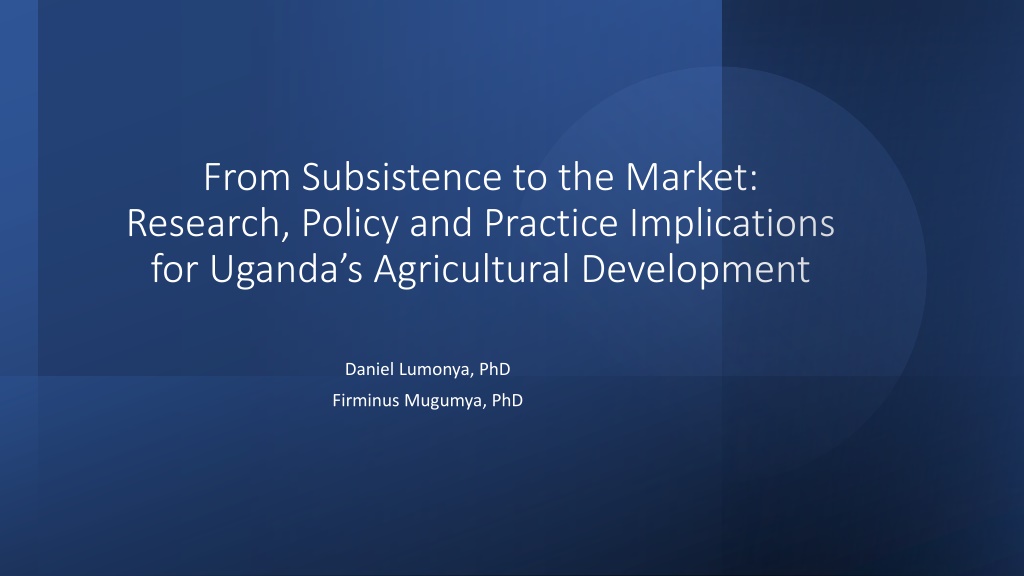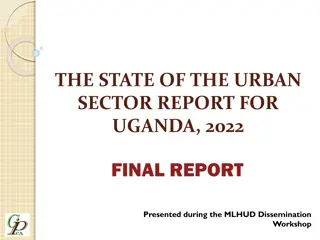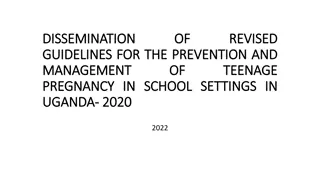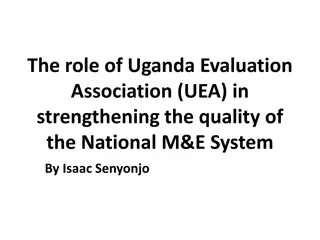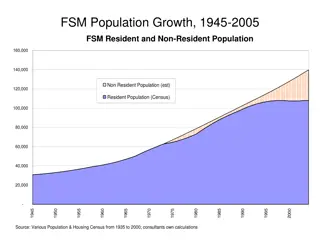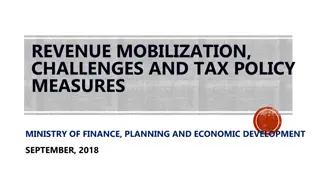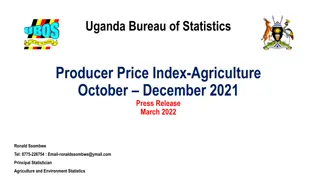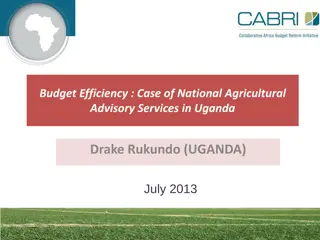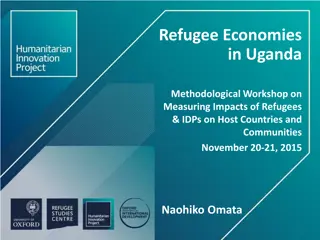Agricultural Development in Uganda: Transitioning from Subsistence to Market Economy
Uganda's agricultural sector plays a significant role in the economy, with a high percentage of households engaged in agriculture. However, many households are still trapped in subsistence farming, hindering overall GDP contribution. Disparities in poverty distribution across regions impact agricultural performance differently. Understanding production trends in various crops like grains provides insight into the sector's challenges and growth opportunities.
Download Presentation

Please find below an Image/Link to download the presentation.
The content on the website is provided AS IS for your information and personal use only. It may not be sold, licensed, or shared on other websites without obtaining consent from the author. Download presentation by click this link. If you encounter any issues during the download, it is possible that the publisher has removed the file from their server.
E N D
Presentation Transcript
From Subsistence to the Market: Research, Policy and Practice Implications for Uganda s Agricultural Development Daniel Lumonya, PhD Firminus Mugumya, PhD
Key questions How have Ugandan households contributed to Uganda's growth overtime? How has government of Uganda interventions supported/facilitated households to move from subsistence to a market economy? What can we learn? What kind of policies can help households to sustainably transition from subsistence to the market economy?
The context: characteristics of Ugandas agriculture Agriculture contributes 25% to GDP. Many households (83%) are engaged in agriculture. It means 83% are contributing only 25% of GDP. About 38% (3 million) of these households are trapped in subsistence, i.e., they produce only for own consumption. Poverty and subsistence are not the same thing: some subsistence farmers (pastoralists) are not asset poor. Pastoralists constitute about 700,000 households. Our concern is mainly with 2.3 million households, most of whom live in northern and eastern Uganda.
The context: poverty and prosperity are unevenly distributed Distribution of poverty is skewed towards the east and north. Poverty has reduced fastest in western Uganda and in Ankole in particular. Central has historically had better poverty figures. What is the relationship between the distribution of poverty and the performance of the different agricultural enterprises?
Total volume of agricultural production in billion tons 2015-2019 We see a gradual decline in total agricultural production between 2015 and 2017. Why? We see a sharp increase from 2017 to 2019. What enterprises are contributed to this growth? Which ones are declining? Why? What lessons can we draw from those that are growing to inform policies that address those that are declining?
Production Trends: Grains We see a sharp decline in all these grain crops from 2015 to 2019. Why? Production begins to stabilize after 2017 but sorghum and millet continue to decline. Production of rice begins to improve from 2018. Production of Sorghum and millet is much lower than the 2015 levels. Wheat, which have increased by 400% between 2010 and 2021, may be displacing sorghum and millet.
Production Trends: Grains: Maize Relative to other grains (Rice, Millet, Sorghum) the production of maize has risen sharply. Maize is grown in most parts of Uganda but most intensely in eastern, central and western (Masindi, Kamwenge, Kyenjonjo, Kasese, Kabarole). Maize is supported by a strong local and regional market: close to 90% of the maize is exported.
Total Production Trends: Legumes The production of beans has dropped sharply (42%), while soya bean (317%) has risen sharply, and groundnuts increased negligibly (2.1%). Beans continue to contribute to the largest share of legume production. All three legumes can be grown in most tropical regions of the country. Soya bean has a comparatively more developed value chain, followed by ground nuts.
Production Trends: Tubers 2015 -2019 Cassava has risen sharply, relative to other tubers. Cassava is grown in most parts of the country, but largely in eastern and western Uganda). Increase in cassava production may be due to climate change and/or availability of resistant varieties. The production of Irish potatoes has grown by 88.3%, but actual contribution to legume production remains low. Irish potatoes are majorly grown in the high land areas of Kapchorwa and Kabale. Irish potatoes have a strong market in Uganda s urban areas. The production of sweet potatoes has dropped 27.4%.
Production of bananas (all types), 2015-2019 The data shows a drop in the production of bananas from 2015 to 2016. We then see a sharp production rise from 2016 to 2019. Bananas have a strong urban market. Presidential initiative on banana industrial development.
Perc. Increase/decrease in production per household for major food crops Growth highest in soya beans, cassava, Irish potatoes, bananas and maize. Largest decline in sorghum, beans, sweet potatoes, and millet. The actual volumes of soya beans and area cultivated remain low in relative terms.
Analysis of the trends in the production of crops We also see a relatively sharp growth in the production of maize, while rice remains flat. Bananas, maize, Irish potatoes, and cassava are the food crops contributing fastest to growth. The food system may be getting less diverse with increasing bananafication, cassavafication and maizefication of Uganda s food system. Further below we examine the contribution of major triggers of growth and decline in the production of food crops.
Trends in the Production of Major Cash Crops Robusta coffee has increased relative to Arabica coffee and Tea. Cotton production has declined sharply. What explains the sharp growth in production of Robusta coffee? What can we learn from this? What is the proportion of the households that are participating in each enterprise over time? Tea is likely to grow given recent tea seedling distribution.
Perc. Increase/decrease in production of major cash crops The production of Robusta coffee has increased sharply. UCDA and a presidential initiative on coffee The production of Arabica coffee has increased marginally. Arabica areas may be saturated. A comparative advantage exists in Robusta, which can be grown in most low-lying areas The increase in the production of tea is negligible. But has a huge potential given recent distribution of 5 million seedlings largely in southwestern Uganda The production of cotton has dropped sharply. Markets and the value chain is under-exploited
Region Area in Ha No. of Trees Trees in Production No. of H/H Trees/ HH Perc. Western 79,773 94,155,423 61,342,735 265,144 231 23% Eastern 77,709 86,332,784 73,305,543 486,079 151 22% Coffee Production by Region Northern 19,886 27,498,178 20,519,580 92,336 222 6% Central 136,247 151,082,141 109,993,307 611,782 180 38% South- West 40,292 49,549,569 29,430,081 258,182 114 11% Total 353,907 408,618,095 294,591,246 1,713,523 238 100% Central, Eastern, and southwestern regions have the ecology suitable for growing coffee (Robusta). And yet only 38%, 22%, 11% of the households in these regions are growing Robusta coffee. Our data shows further that about only about 1.7 million, (20%) H/H are growing coffee.
Areas suitable for growing coffee With a high altitude and fertile soils Uganda has a high comparative advantage for arabica coffee growing. The world market for coffee is projected to grow. The potential for Robusta coffee growing is highly underutilized.
Areas suitable for growing cotton Uganda has a high comparative advantage for cotton production. The country s cotton potential is highly under exploited. Other countries in the region are doing well, indicating that Uganda could also do well. The cotton value chain could be developed and protected from competition.
Production: Total Number of Major Farm Animals Total number of major farm animals is generally flat. Chicken are by far the largest, but we see a decline in their numbers. Cattle numbers are declining. Restocking program for northern Uganda.
Livestock by region Northern region leads in cattle, goats, sheep and is third in chicken. Western is second in cattle, goats and sheep, pigs and has relatively fewer chickens. Central has as many cattle as eastern and western, has the most pigs, and has the least goats and sheep. Eastern has the largest share of chickens, is second in pigs and goats, and has as many cows as western and central.
Average Number of Major animals per H/H, 2014 to 2019 Average number of major animals is declining. Chicken and Cattle are declining. Cattle: intensification? Cattle: A shift to more productive breeds? Chicken: diseases and poor production systems.
Perc increase in animal husbandry products 2013 and 2018 Milk shows the sharpest increase, followed by pork, poultry, goat and beef. Milk also has the most developed value chain.
Average/per H/H increase in animal husbandry production 2013 to 2018 Highest increase is in milk (16%). All other productions show a negative average per household increase in production.
Enterprise Domestic MKT International Export Presence of R & D Govt Authority Developed value chain Maize Yes Yes Yes No No Rice Yes No Yes No No Sorghum Weak Weak Weak No No Millet Weak Weak Weak No No Soya Bean Yes Weak Yes No Yes Groundnuts Yes Weak Weak No No Irish Potatoes Yes Weak Yes No Yes Sweet Potatoes Weak Weak Yes No No Cassava Yes Weak Yes No No Beans Yes Weak Weak No No Coffee Weak Yes Yes Yes Yes Tea Yes Yes Weak Yes Yes Cotton Weak Weak Weak Yes No Milk Yes Yes Yes Yes Yes Beef Yes No Yes Yes No
Key conclusions Uganda s rural households are heavily integrated in commodity markets; they increasingly rely on cash for the social reproduction, which means that market imperatives have a high potential to trigger production and household participation in markets. Therefore, households respond quickly to market dynamics: this is the case with bananas, maize, soya bean, milk, coffee. Enterprises with a strong value chain/ value addition have attracted production, e.g., milk. Cassava may be doing well for three reasons: wide distribution of disease resistant varieties, value addition for the urban market or due to climate change (an anticipated changes). We are unable to explain the sharp decline in agricultural produce between 2015 and 2017. Such a large drop across the country can only be explained by a large-scale phenomenon such as climate change.
Seven key policy recommendations: 1. Adopt an enterprise specific development strategy that targets the unique circumstances of the different households. a) Especially Robusta coffee, cotton and local free-range chicken, etc. b) Build upon the NARO structures (NACRI, increasing funding and outputs. 2. Provide additional support to extension across key agricultural enterprises. a) For example, Robusta is doing well but the country s potential to produce Robusta coffee is underutilized. b) Extension to support local chicken production will target the poorer households in eastern and northern Uganda. 3. Design specific strategies to develop markets for agricultural enterprises. a) There is overwhelming evidence that farmers now respond very fast to market imperatives. b) Stabilize the agricultural enterprise markets/support farmers to participate in value addition activities. 4. Protect local grains (sorghum and millet) from substitute imports. a) Urban consumption lifestyles have shifted to imported grain, especially wheat and rice. b) Promote consumption of healthy lifestyles and impose higher taxes on imported grain. c) Invest in developing the value chains of sorghum and millet. 5. Design strategies that trigger local demand for neglected and under-utilized crops. a) For example, compared to other legumes Soya beans have comparatively a larger potential to earn H/H income. b) Disseminate information on the nutritional potential of neglected and underutilized crops. 6. Expand coffee extension services provided through UCDA. a) UCDA strategy is bearing exceptional results in Robusta production and should be expanded. 7. The Parish Development Model presents a unique opportunity to roll out these new policy proposals and projects. a) Build capacity on both the supply and demand side. b) PDM could be better informed by location specific research
